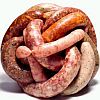Revisiting this subject has raised some interesting questions. My observations are:
1. Acidophilus obviously works in reducing PH - see link to research, and post above.
2. From the Holland & Barrett label we see that each of their Acidophilus tablets contains between 140mg and 141.5mg of active preventive cultures. (approx 7 tablets will give 1gm cultures)
3. Oregon state university state a usage rate of 0.5%, 5gm/1000gm meat or sausage, so each kg meat or sausage in theory needs 35 tablets. If this is correct we would also be adding 12.5gm per kg of other things that are in the tablets: Bulking Agents (Dicalcium Phosphate, Microcrystalline Cellulose), Citrus Pectin, Anti-Caking Agents (Silicon Dioxide, Magnesium Stearate).
4. HFW uses 1.5gm powder in about 615gm sausage (salami - 400gm meat, 100gm fat) to "to develop the correct (non-threatening) mould." Not, on the face of it, to reduce PH. He says you can use ground up tablets but quotes a figure for powder which doesn't have the same bulking agents (at least thishasn't). 1.5gm would be about 10 tablets if this supposition is correct.
5. There is a massive difference between the two, surely both of them can't be right!
6. Cost:
LS-25 costs <10p per kg sausage
Pure Acidophilus powder at 0.5% per kg about �1.50
Tablets at 35 per kg about �2.10
Even at a reduced % useage Acidophilus appears more expensive.
7. Ease of use
Acidophilus appears to be a 'shelf stable' product, easier to store and probably use.
I am now loath to buy, and PH test this. Firstly, I'm not sure my schoolboy science is adequate to carry any authority if I show any test online. Secondly, even if I have to dispose of some LS-25 at it's 'use by', it will still probably be cheaper.
Does anyone have further information on the subject?
Phil
Fermented Air Dried Sausage
68 posts
• Page 5 of 5 • 1, 2, 3, 4, 5
HFW's recipe calls for 3 capsules per 500/600g meat so say 5 per kilo. They are �6.25 for 100 so that's ~30p per kilo of meat. I think the capsules are many times more active than the tablets, as each one contains 3 billion viable cells. Although culture is still cheaper if you can get hold of some.
Dave
Dave
Curing is not an exact science... So it's not a sin to bin.
Great hams, from little acorns grow...
Great hams, from little acorns grow...
-

saucisson - Site Admin
- Posts: 6851
- Joined: Sat Mar 04, 2006 8:46 pm
- Location: Oxford UK
Dave
My error I had read the contents of the powder incorrectly.
I had read the contents of the powder incorrectly.
This leaves the issue of the difference between the usage by HFW and Oregon State Uni - it's interesting to note that neither say it is used to reduce PH (increase acidity).
The Hungarian Salami experiments say, in the resume:
I'm still confused as to acidophilus's role and effectiveness when used alone.
Phil
Phil
My error
This leaves the issue of the difference between the usage by HFW and Oregon State Uni - it's interesting to note that neither say it is used to reduce PH (increase acidity).
The Hungarian Salami experiments say, in the resume:
R�sum� / Abstract
Listeria monocytogenes and Escherichia coli O111 have been implicated in several outbreaks of food-borne disease linked to smallgoods products. Traditional meat starter cultures, containing a mixture of lactic acid bacteria (LAB) and staphylococci, are used to maintain safety and sensory properties of Hungarian salami. The present study investigated if nontraditional meat starter (NTMS) cultures can be used for improving the safety of Hungarian salami. Salami batter was inoculated with List. monocytogenes and E. coli and subsequently fermented with NTMS cultures and a commercially available meat starter. A total of 15 NTMS cultures were tested. The salami was monitored for levels of pathogen, LAB and pH. When used in conjunction with the commercial meat starter, 9 NTMS cultures reduced the E. coli O111 count by more than 2.5 log units, whereas 10 of the NTMS cultures reduced List, monocytogenes by more than 2.5 log units. The commercial meat starter alone reduced E. coli and List, monocytogenes by 1.2 and 1.3 log units, respectively. Some NTMS cultures reduced the pathogen count without affecting pH of the salami batter. All NTMS cultures survived in salami throughout fermentation and maturation. It was concluded that NTMS cultures, including Lactobacillus acidophilus LAFTI L10, L. paracasei LAFTI L26, L. paracasei 5119, Lactobacillus sp. L24 and Bifidobacterium lactis LAFTI B94, may be used to increase the safety of Hungarian salami because these cultures gave strong inhibition of both E. coli O111 and List. monocytogenes.
I'm still confused as to acidophilus's role and effectiveness when used alone.
Phil
Phil
-

wheels - Global Moderator
- Posts: 12894
- Joined: Sat Sep 02, 2006 4:29 pm
- Location: Leicestershire, UK
I think, and I freely admit I'm skating on thin ice here, that some of the NTMS cultures don't produce much lactic acid, so don't reduce the pH. Acidophilus does though and is the bacteria responsible for making sauerkraut vinegary.
Curing is not an exact science... So it's not a sin to bin.
Great hams, from little acorns grow...
Great hams, from little acorns grow...
-

saucisson - Site Admin
- Posts: 6851
- Joined: Sat Mar 04, 2006 8:46 pm
- Location: Oxford UK
68 posts
• Page 5 of 5 • 1, 2, 3, 4, 5
Return to Sausage Making Techniques
Who is online
Users browsing this forum: No registered users and 0 guests

